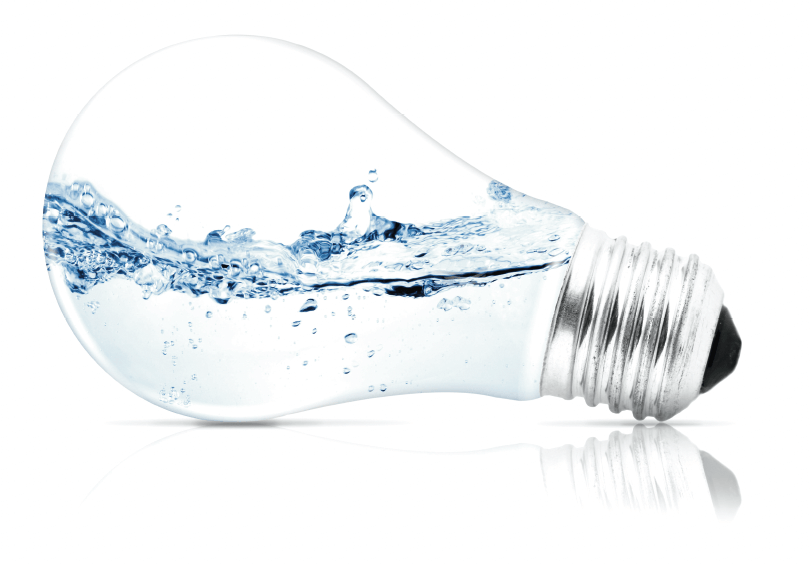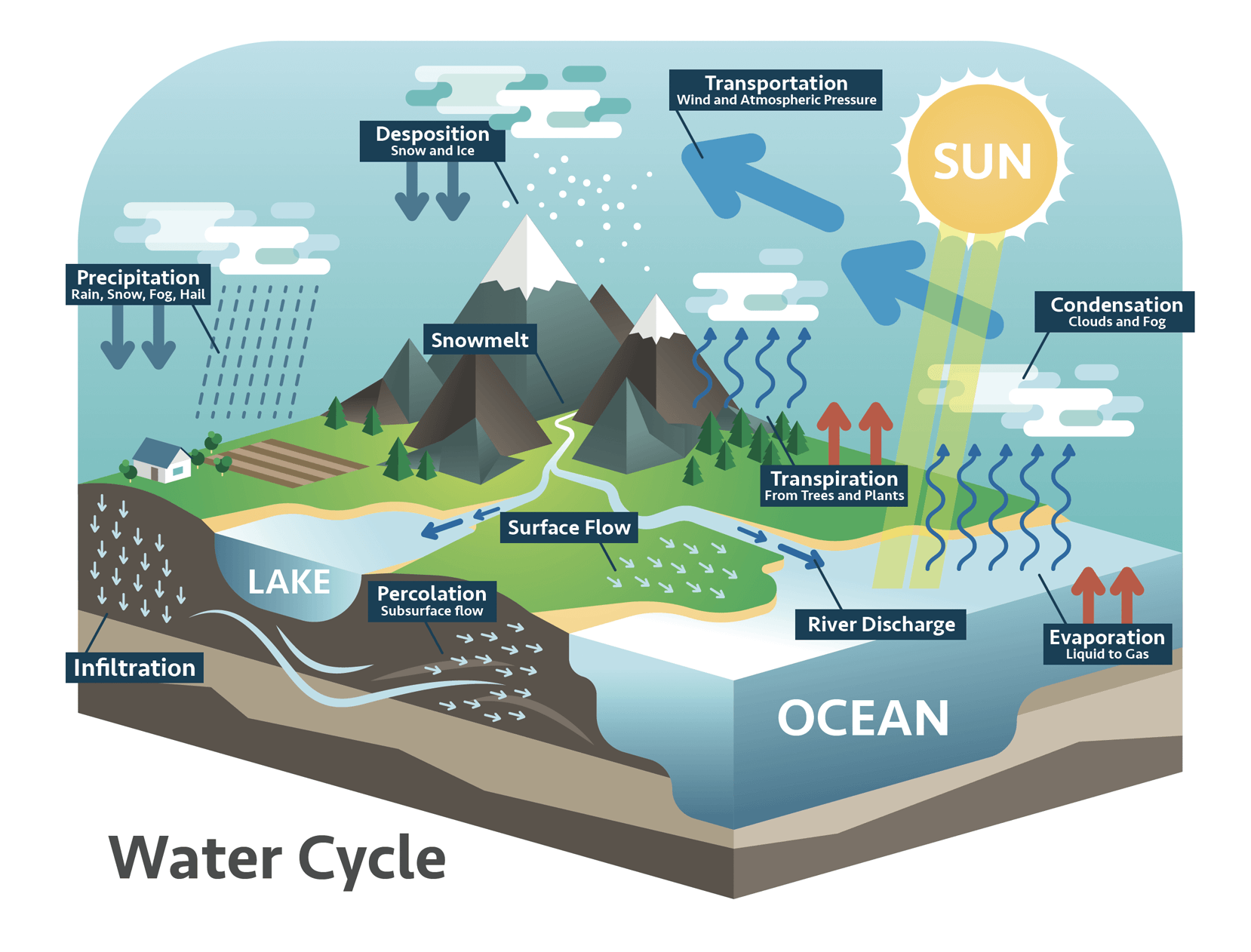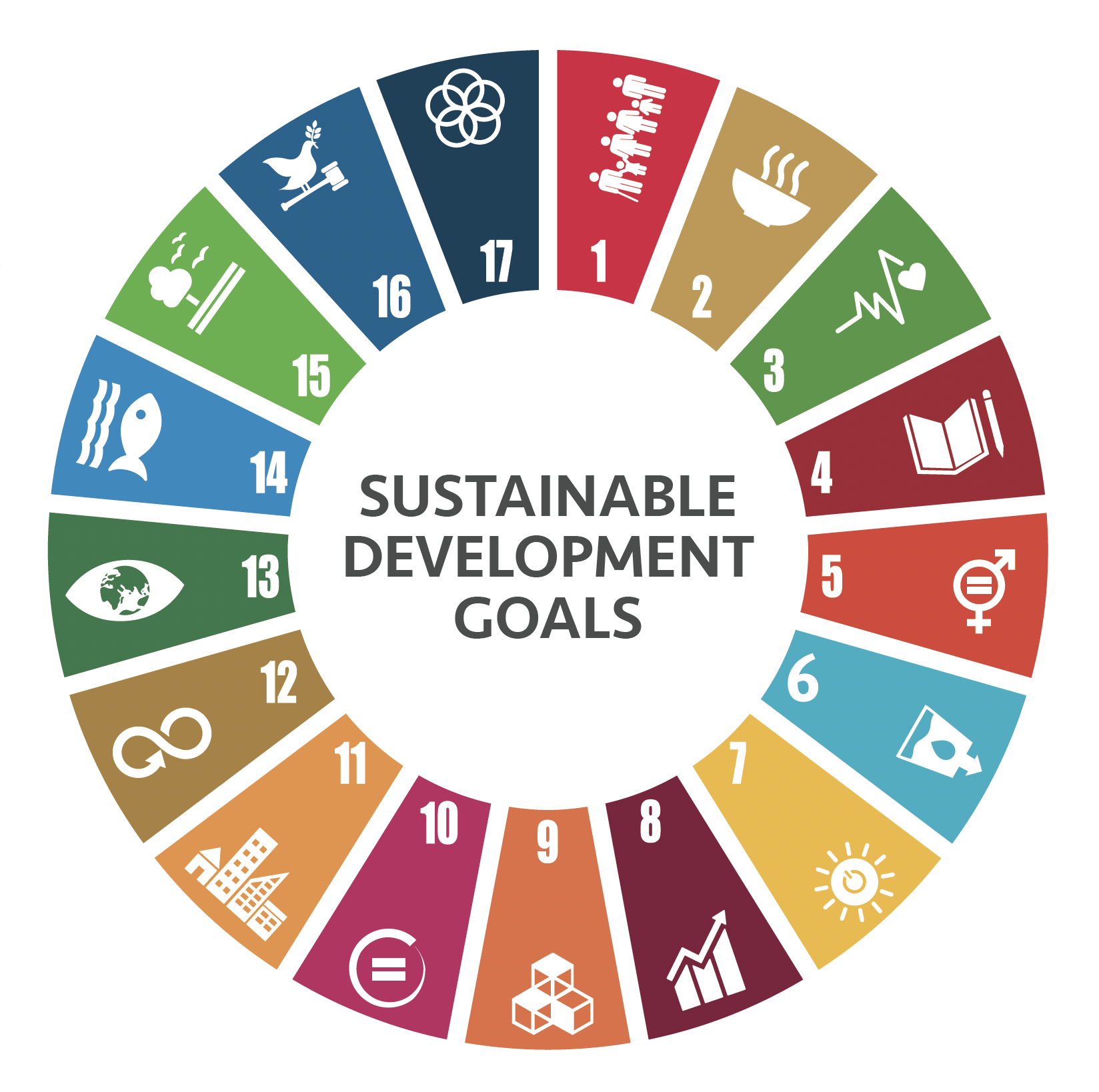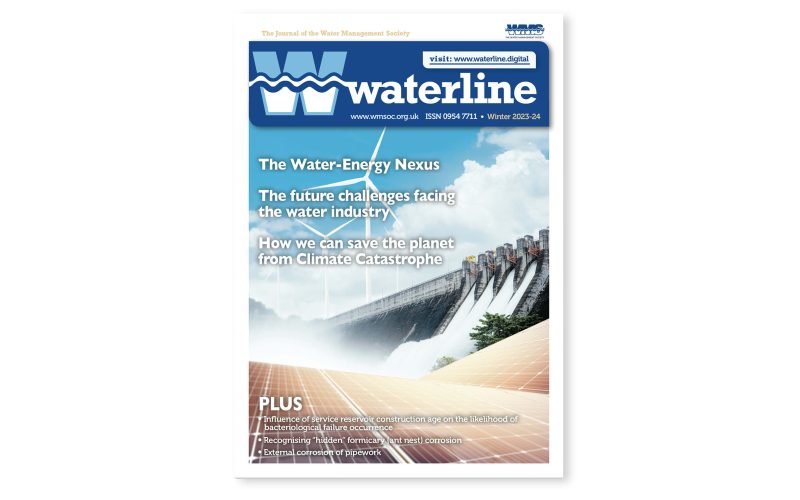As featured in Waterline Winter 2023-24
The Water-Energy Nexus
By Anthea Davies MSc, CMIOSH, FRSC, AIEMA, MWSoc. – ADepta Consulting Limited.
‘The Water-Energy Nexus’ explores the connection between water and energy and how this dependency impacts upon the water cycle and future changes in the climate.
What is the energy nexus:
Definition: a connection or series of connections linking two or more things.
Demand for water is rising owing to rapid population growth, urbanisation and increasing water needs from agriculture, industry, and energy sectors. Demand for water is projected to increase by up to 30% by 2050; while energy demand is predicted to rise by nearly 10% by 2030 (World Resources Institute). This will pressurise an existing water and energy system because of the shortage of supply that exists in many regions of the world. The demand for water has outpaced population growth, and half the world’s population is already experiencing severe water scarcity at least one month a year. (Global Risks Report 2023). The environmental crisis due to unsustainable water and energy consumption is becoming the biggest global risk and is addressed within The Sustainable Development Goals Report 2023.
Water and energy systems have an inextricably mutual effect. Water scarcity is already having an impact on energy production and reliability.
Water for energy: Energy production is a significant consumer of water resources. For example, thermal power plants, including coal, natural gas, and nuclear power plants, require large amounts of water for cooling purposes. Water scarcity or the inefficient use of water in energy production can affect the reliability and availability of energy. Based on the statistics, more than 90% of global electricity generations are depending on water. For example, increased water stress has a material impact on the cooling technologies (and related costs) deployed across China’s coalfired power fleet.
Energy for water: Water supply, treatment and distribution processes require substantial energy inputs.
Water pumping, desalination and wastewater treatment plants are energy intensive. Therefore, disruptions or high energy costs can impact water availability, quality and affordability.

Diminished freshwater resources can lead to a greater reliance on energyintensive sources of water supply such as desalination. In the Middle East, desalination’s share of total final energy consumption is predicted to increase from 5% today to almost 15% by 2040. The largest increase comes from desalination, followed by large-scale water transfer and increasing demand for wastewater treatment (and higher levels of treatment).
Due to this mutual relation between water and energy resource, increasing energy efficiency can reduce pressure on water resource, and improving water efficiency can also reduce the consumption of energy. In general, the improvement of a diverse supply of energy will be feasible if the quality and quantity of water are rising. Inversely, enhanced energy capacities accelerate the ability to produce clean water. However, there is significant potential for energy savings in the water sector if all the economically available energy efficiency and energy recovery potentials in the water sector are exploited. Wastewater contains significant amounts of embedded energy that, if harnessed, could cover more than half of the electricity needs of municipal wastewater utilities. There is also a major opportunity to reduce water losses along the supply chain – from leaks, bursts and theftwhich would save water and energy. As a result, the concept of waterenergy nexus has attracted great concern in recent years, because of the global attention for water and energy security. The concept was discussed in the World Economic Forum in 2008, where the global challenges in terms of economic growth were identified from the water-energy nexus viewpoint. Since then, water–energy nexus issues have become increasingly important and is addressed annually in the Global Risks Reports.
The water cycle:
Traditionally most countries collect fresh water through the water cycle. Earth’s water cycle has been around for some 4 billion years. As water on land and in rivers and sea warms, it evaporates and by convection rises up into the cold air above, condensing as clouds which when they become too heavy, fall back to earth as rain sleet, ice or snow. Rainwater runs off the land into streams, brooks and rivers or is taken up by the ground and with suitable rock formations permeating to underground reservoirs of water. Some water is held as snow or ice at high altitude or near the planet’s poles. During past ice-ages, this ‘storage’ predominated and slowed the cycle.
However new studies have found that the water cycle is changing. Rising global temperatures, as a result of climate change, are causing water to evaporate faster. This is accelerating the water cycle, which could have a significant impact on our oceans and ecosystems.

The temperature of the world’s ocean surface has hit an all-time high since satellite records began, leading to marine heatwaves around the globe, according to US government data. Climate scientists said preliminary data from the National Oceanic and Atmospheric Administration (Noaa) showed the average temperature at the oceans’ surface has been at 21.1 oC since the start of April – beating the previous high of 21 oC set in 2016.
A faster water cycle increases the likelihood of extreme weather events and contributes to the melting of polar ice. The Greenland and Antarctic ice sheets are now losing more that three times as much ice a year as they were 30 years ago, according to a new comprehensive international study. Using 50 different satellite estimates, researchers found that Greenland’s melt has gone into hyperdrive in the last few years. Greenland’s annual melt from 2017 to 2020 was 20% more a year than at the beginning of the decade and more than seven times higher than its annual shrinkage in the early 1990’s. From 1992 to 1996, the two ice sheets – which hold 99% of the worlds freshwater ice – were shrinking by 116 billion tons (105 billion metric tons) a year, two thirds of it from Antarctica. But from 2017 to 2020, the newest data available, the combined melt soared to 410 billion tons (372 billion metric tons) a tear, more than two thirds of it from Greenland, said the study in the Journal Earth System Science Data.
The State of Global Water Resources Report 2022 emphasises the effects of weather and climate events on the various aspects of the water cycle. In this light, the report acts as a vital stride towards fulfilling the United Nations Secretary-General’s vision of establishing a comprehensive early warning system for all in the coming years, as well as contributing to achievement of the Sustainable Development Goals (SDGs) and other global objectives related to water, energy and climate change.
Goal 6 – Ensure availability and sustainability management of water and sanitation for all.
Goal 7 – Ensure access to affordable, reliable, sustainable and modern energy for all.
Goal 13 – Take urgent action to combat climate change and its impacts.
Climate change:
The energy-water nexus is closely linked to climate change. Climate change affects water availability, with changes in precipitation patterns, droughts and increased water stress. At the same time, energy production and consumption contribute to greenhouse gas emissions, which exacerbate climate change impacts on water resources and in turn the global water cycle. The UK, like many other countries, is experiencing the effects of climate change. Water treatment systems need to adapt to changing conditions, such as altered rainfall patterns, increased frequency of extreme weather events and rising sea levels. Future water treatment strategies may focus on resilience and the ability to handle potential water scarcity and quality issues resulting from climate change.

Climate and environmental risks are the core focus of global risks perceptions over the next decade – and are the risks for which we are seen to be the least prepared. The lack of deep, concerted progress on climate targets has exposed the divergence between what is scientifically necessary to achieve net zero and what is politically feasible. Growing demands on public-and private-sector resources from other crises will reduce the speed and scale of mitigation efforts over the next two years, alongside insufficient progress towards the adaptation support required for those communities and countries increasingly affected by the impacts of climate change. As current crises divert resources from risks arising over the medium to longer term, the burdens on natural ecosystems will grow given their still undervalued role in the global economy and overall planetary health. Nature loss and climate change are intrinsically interlinked – a failure in one sphere will cascade into the other. Without significant policy change or investment, the interplay between climate change impacts, biodiversity loss, food security and natural resource consumption will accelerate ecosystem collapse, threaten food supplies and livelihoods in climate-vulnerable economies, amplify the impacts of natural disasters, and limit further progress on climate mitigation. (Global risks 18th edition – World Economic Forum).

The climate change emergency has brought forward the need to re-think how we humans interact with the environment. Should we be allowed to extract natural resources from the earth to accommodate our energy needs? Should we use plastic packages and then throw them away in the sea? While technological advances provide sustainable ways to tackle such matters, any reply we give to these questions is also largely determined by how we understand our relationship with nature. For any progress to be made around climate change, we have to re-address how we perceive (and should perceive) this relationship.
Throughout the 16th – 18th centuries, the series of events that we now call the scientific revolution marked the emergence of science as we know it. Prior to the scientific revolution, the most dominant image of nature represented the earth as a living organism – e.g. Leonardo da Vinci referred to rivers as the veins of earth, circulating like the blood system from the mountains to the sea. With the scientific revolution, this changed radically. Nature became a configuration of passive lifeless matter; something people should dominate via technology. It became morally permissible – if not expected – to take advantage of natural resources to achieve economic, social and scientific progress.
This illuminates how our attitude towards nature is intertwined with the culture in which we live and is shaped by the often-implicit assumptions and beliefs that we have been raised to accept. More importantly, it helps show why it has become culturally permissible that nature is manipulated and exploited and may even explain why it is so difficult to collectively agree on how to stop harming it. Perhaps we will finally see that a solution to the climate change emergency does not merely come down to creating sustainable technological solutions; it also requires a radical reconception of our place in the world. (Rethinking Nature – RSC Library).
Managing the Water-Energy nexus in the future:
Efficiency and conservation: Enhancing energy and water efficiency is crucial for managing the waterenergy nexus. Technologies that reduce water consumption in energy production and improve energy efficiency in water treatment and distribution can help mitigate resource constraints. Advances in energy-efficient water treatment and distribution technologies can minimise energy consumption in water related processes. For instance, the development of low-energy desalination techniques or smart water management systems can reduce the energy intensity of water supply and wastewater treatment, making them more sustainable and cost-effective.
Energy plays a crucial role in desalination, the process of turning seawater into freshwater. By developing more efficient desalination technologies and integrating renewable energy sources, we can enhance water security in water stressed regions and reduce the environmental impacts of the process.
Billions of people around the world lack access to clean water – if not every day, then at some point during the year. One example of the freshwater crisis is in the Middle East; countries in the region are classified as at severe risk of water stress by the World Resources institute and rely on desalination and water purification systems. At the moment, desalination and water treatment are dominated by reverse osmosis membranes, which relies on applying pressure to force water through a partially permeable membrane, overcoming the dominant osmotic pressure and filtering out any contaminants in the process. Although very effective, the process is highly energy dependant.
For countries in the Middle East, the availability and cost of large quantities of energy is acceptable; however, this level of energy resource cannot be afforded by poorer countries around the world. The UN Sustainable Development Goal 6 – is to ensure availability and sustainable management of water and sanitation for all.

Improving water desalination and purification strategies are therefore on many chemists’ and engineers’ agendas and new technologies including Nanotechnology and materials science are becoming the bedrocks of new water purification technologies. e.g. Researchers in Japan have designed a series of fluorinated nanochannels able to remove salt and other impurities from contaminated water samples. With a purification rate three orders of magnitude greater than the alternatives, the team is confident that this technology can be developed for water treatment and desalination applications. These nanomaterial-based membranes have excellent potential to be the future technology for water purification and be less energy intensive, but there are still major hurdles for the application of these materials on a commercial scale.
(Ref: 2 – Chemistry World July 2022).
Smart water systems: The integration of digital technologies and smart sensors is revolutionising water treatment and distribution systems. These systems can monitor water quality parameters in realtime, optimise treatment processes, detect leaks and enable predictive maintenance. By leveraging data and automation, water companies can improve efficiency, reduce costs and enhance the overall management of drinking water supplies.
Smart water systems:
The integration of digital technologies and smart sensors is revolutionising water treatment and distribution systems. These systems can monitor water quality parameters in realtime, optimise treatment processes, detect leaks and enable predictive maintenance. By leveraging data and automation, water companies can improve efficiency, reduce costs and enhance the overall management of drinking water supplies.
Research and innovation:
Addressing the energy-water nexus requires continuous research and innovation, which can lead to the developments of new technologies, processes and policies. These advancements can drive positive change by enhancing water and energy efficiencies, promoting renewable energy adoption and improving overall resource management. To address water scarcity concerns, water reuse initiatives are gaining traction. Recycled treated wastewater for non-potable uses like irrigation or industrial processes can help conserve freshwater resources.
Sustainable agriculture:
The water-energy nexus is a vital role in agriculture and sustainable practices can lead to positive outcomes. Agriculture is the largest consumer of the world’s freshwater resources. Energy-efficient irrigation systems such as drip irrigation or precision farming techniques, reduce water and energy waste, leading to improved crop yields and resource conservation. Additionally, renewable energy can power agricultural operations, reduce reliance on fossil fuels and promote environmental sustainability.
Renewable energy and water aquifer recharge:
The deployment of renewable energy sources, such as solar and wind power, can reduce water consumption in energy production compared to conventional fossil fuelbased technologies. However, some renewable energy technologies such as hydropower can have significant impacts on local water resources and ecosystems.
Renewable energy can power water treatment processes, reducing reliance on fossil fuels. Solar energy can be used for water disinfection and purification, while biogas produced from wastewater treatment plants can generate electricity.
Renewable energy sources can facilitate aquifer recharge, where excess energy is used to replenish underground water reserves. By strategically managing energy resources, we can optimise the recharge of aquifers, thereby ensuring sustainable water supplies.
Integrated approaches and synergistic solutions:
Addressing the energy-water nexus requires an integrated and interdisciplinary approach. Policies, planning and management strategies should consider the interactions between energy and water sectors to ensure sustainable resource use, minimise conflicts, and promote resilience.
The energy-water nexus encourages collaboration and integrated planning across sectors and stakeholders. Recognising the interdependencies between energy and water fosters partnerships and joint initiatives aimed at achieving sustainable outcomes. Through co-ordinated efforts, communities can develop strategies to optimise resource use, increase resilience and enhance both energy and water security.
Many water and energy infrastructure projects offer co-benefits. For instance, constructing hydropower plants not only generates electricity but also facilitates water storage and supply for irrigation, drinking water and industrial purposes.

Recognising the nexus can inspire innovative solutions that address multiple challenges simultaneously. For example, the development of micro-hydropower systems can provide decentralised electricity to remote communities while supporting small-scale irrigation and water pumping.
Decision making related to the energywater nexus often involves tradeoffs. For example, increasing water availability for energy production through water diversions can impact ecosystems and local water users. Balancing the needs and priorities of energy and water sectors requires careful consideration of social, economic factors.
Ecosystems must be valued for their vital services:
Governments must harness the power of nature instead of allowing its destruction and degradation in the pursuit of food and energy. ‘Green infrastructure, such as land dams to capture run offs in arable fields or planting forests to protect sill and assist groundwater recharge, are some examples of creating a more sustainable water-food-energy nexus and a ‘greener’ economy. (UN Water).
Public awareness and education:
Raising awareness about the positive aspects of the water-energy nexus can foster a better understanding of the challenges and opportunities. Increased knowledge can encourage individuals, businesses, and policymakers to adopt sustainable practices and support the development of integrated solutions.
On a final note: Water scarcity is projected to increase with the rise of global temperatures as a result of climate change. Energy consumption is expected to increase as global population rises. Water availability is becoming less predictable in many places and is a factor in speeding up the global water cycle. In some regions, droughts are exacerbating water scarcity and thereby negatively impacting people’s health and productivity and threatening sustainable development and biodiversity worldwide. To meet the UN Sustainable Development Goals, a more integrated and holistic approach to water and energy management needs to be adopted. By embracing a positive perspective on the water-energy nexus, we can promote collaboration, innovation and sustainable development, ensuring the efficient use of resources while safeguarding the environment and enhancing the well-being of communities worldwide.












